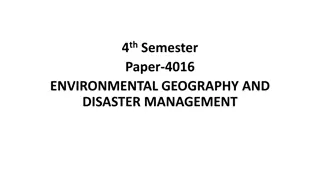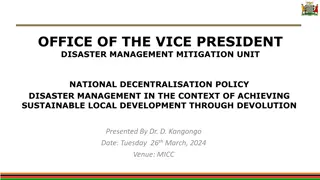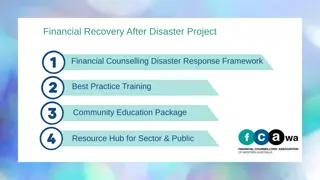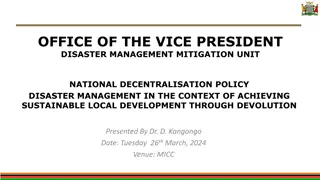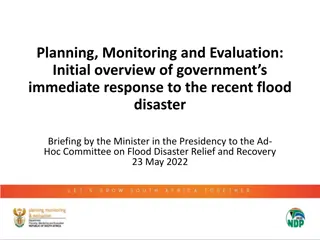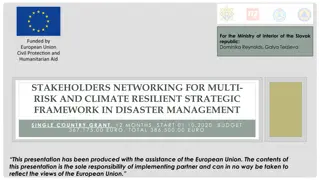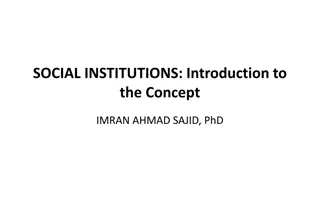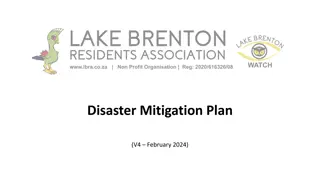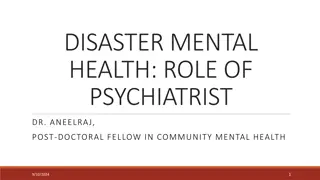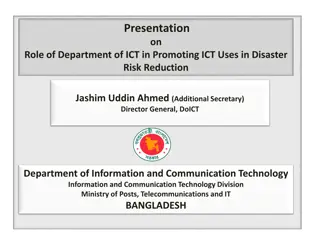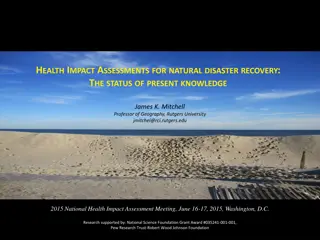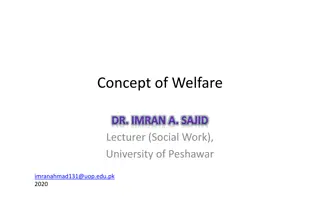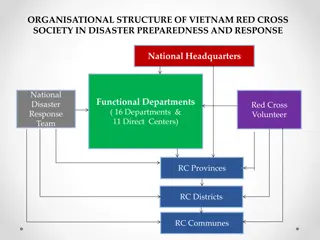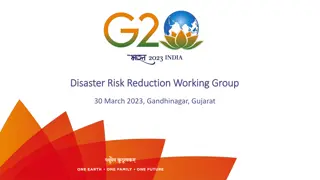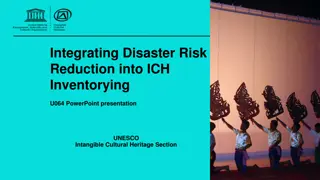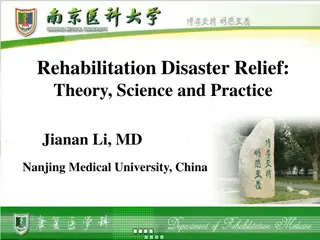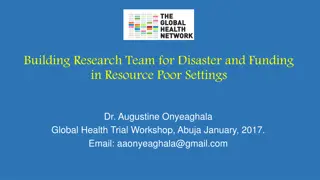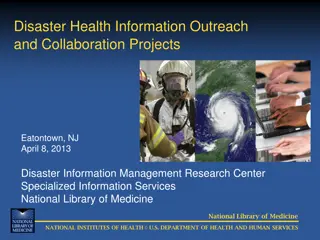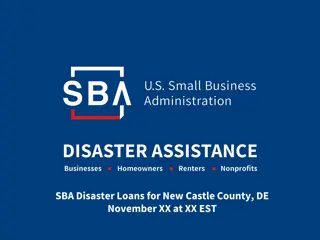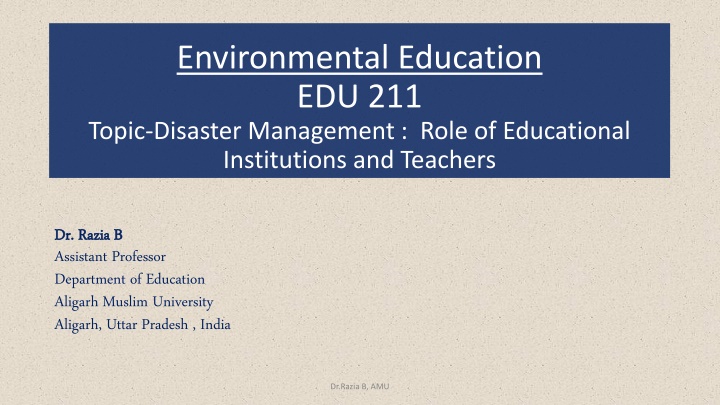
Role of Educational Institutions in Disaster Management
Disaster management involves understanding the different types of disasters, their impacts, and the steps to manage them effectively. Educational institutions and teachers play vital roles in preparing individuals and communities to handle disasters. This lesson by Dr. Razia B from Aligarh Muslim University provides insights into disaster definitions, management strategies, and the significant contributions of educators in disaster preparedness and response.
Uploaded on | 15 Views
Download Presentation

Please find below an Image/Link to download the presentation.
The content on the website is provided AS IS for your information and personal use only. It may not be sold, licensed, or shared on other websites without obtaining consent from the author. If you encounter any issues during the download, it is possible that the publisher has removed the file from their server.
You are allowed to download the files provided on this website for personal or commercial use, subject to the condition that they are used lawfully. All files are the property of their respective owners.
The content on the website is provided AS IS for your information and personal use only. It may not be sold, licensed, or shared on other websites without obtaining consent from the author.
E N D
Presentation Transcript
Environmental Education EDU 211 Topic-Disaster Management : Role of Educational Institutions and Teachers Dr. Dr.Razia B Razia B Assistant Professor Department of Education Aligarh Muslim University Aligarh, Uttar Pradesh , India Dr.Razia B, AMU
By the end of this Lesson, the learners will be able to Define the term -Disaster Differentiate between Natural and Manmade Disaster Highlight the adverse impact of a disaster on earth Explain disaster management in detail Elaborate the steps of disaster cycle Discuss the role of Educational Institutions in Disaster Management Discuss the vital role of teachers in Disaster Management Dr.Razia B, AMU
A disaster occurs due to man-made or natural causes which results in sudden disruption of normal life. Causes severe damage to life and property Disaster impacts are increasing enormously as a result of the combination of increasing human population along with modification and degradation of natural environments. Often results in the destruction of equilibrium in the environment. https://www.sciencedirect.com/topics/earth-and-planetary- sciences/geological-disaster https://en.nhandan.vn/scitech/environment/item/7496202-raising-public- awareness-of-natural-disaster-preparedness.html Dr.Razia B, AMU
"any occurrence, that causes damage, ecological disruption, loss of human life, deterioration of health and health services, on a scale sufficient to warrant an extraordinary response from outside the affected community or area -World Health Organization United Nations Disaster Relief Organization-UNDRO defines disaster as: An event, concentrated in time and space, in which a community undergoes severe danger and incurs such losses to its members and physical apparatuses that the social structure is disrupted and the fulfillment of all or some of the essential functions of the society are prevented (1984) Dr.Razia B, AMU
Disaster is defined as a catastrophe, mishap, calamity or a grave occurrence in any area arising out of natural or man made causes, or by accident or negligence, which results in substantial loss of life and human suffering or damage to, or destruction of, or degradation of environment, and is of such a nature, or magnitude as to be beyond, the coping capacity of the affected community of the affected area . - Disaster Management Act, 2004 Dr.Razia B, AMU
Considerable loss of life and livelihood- Large number of deaths or serious injuries Severe damage to properties Adverse impact on health due to rapid spread of disease or epidemics. Severe disruption of normal life pattern. Considerable disruption of community resources leading to shortage of shelter, food, clothing, medical assistance. Disruption and damage of infrastructure, communications and other essential services. Adverse Impact on Economy Adverse impact on Sociological and Psychological aspects. Dr.Razia B, AMU
The statistics of recorded disaster data show that between 1995 2004 nearly 6000 disasters were recorded, 900000 people lost their lives , US$ 738 billion material losses and a total of 2500 million people affected (Basher,2005). In India, out of the total of the total states and Union territories, 22 are prone to disasters. Among all the disasters that occur in the country, floods are the most frequently occurring natural disasters, due to the irregularities of the Indian monsoon. Approximately 40 million hectares of land in the country has been identified as being prone to floods. Dr.Razia B, AMU
Types of Disasters Natural disaster A major event brought about by the natural processes of the Earth that causes widespread destruction to the environment and loss of life. Catastrophic event that arises due to natural phenomena of Earth. Some Natural Disasters may be due to human intervention. For eg. Landslides may be due to extensive agricultural activities and denudation of forests. Manmade disaster On various occasions in history, our planet has witnessed some of the worst environmental disasters caused by human activities. The disasters range from wars to nuclear explosions, spill, toxic gas leaks, and oil spills. The environmental consequences are adversely high and their impacts are felt for centuries chemical Dr.Razia B, AMU
Natural disaster Manmade disaster Explosions Nuclear disasters Chemical disasters Mine Explosions Fire Accidents Accidents Oil Spills etc. Flood Drought Earth quakes Tornadoes Tsunami Volcanic eruptions Avalanche etc. Dr.Razia B, AMU
Water and Climate Related Disasters Floods, Cyclones ,Tornadoes and hurricanes (cyclones) , Hailstorms , Cloudburst , Heat wave and cold wave , Snow avalanches , Droughts ,Sea erosion , Thunder/ lightning. Geological Disasters Earthquakes, Landslides, Mudflows,, Dam Bursts & Dam Failures, Mine Fires Biological Disasters Epidemics, Cattle Epidemics ,Pest Attacks and Food Poisoning Chemical/Industrial/ Nuclear Disasters Chemical Disasters ,Industrial Disasters, Nuclear Disasters Accident Related Disasters Forest fires , Urban fires , Mine flooding ,Oil spill , Major building collapse , Serial bomb blasts , Festival related disasters , Electrical disasters and fires , Air, road, and rail accidents , Boat capsizing , Village fire Dr.Razia B, AMU
Disaster Management Collective term that refers to all the aspects of planning and responding to disasters. A discipline of dealing with and avoiding risks. Includes both pre-disaster and post-disaster activities. Encompasses management of both the risks and consequences of disasters. A hazard needs to be managed properly otherwise turns into a disaster. It attempts to inquire into the process of a hazard turning to disaster. Identifies the causes and rectify the same through public policy Dr.Razia B, AMU
Disaster Management Disaster and its Management is a continuum of several inter-connected activities. A continuous and integrated process of planning, organizing, coordinating and implementing measures which are necessary for prevention of danger or threat of any disaster mitigation or reduction of risk, capacity building, preparedness, prompt response, severity or magnitude assessment evacuation ,rescue ,relief rehabilitation and reconstruction Nair Gupta and Roder(2013) A continuous process by which individuals, groups, and communities manage a hazard in an effort to either avoid or ameliorate the adverse impact of disasters resulting from the hazard. Also involves preparing for disaster before it occurs. Disaster response (e.g., social distancing/ Quarantine, Mass evacuation, etc.), Includes supporting and rebuilding society after any serious occurred. disaster has Dr.Razia B, AMU
Goals of Disaster Management Dr.Razia B, AMU
Three key stages in Disaster Management: Before a disaster: safety measures are undertaken to reduce human, material and environmental losses due to hazards . It is also to minimize the loss when disaster strikes During a disaster: Quick measures and activities are undertaken to meet the the needs of victims. After a disaster: to achieve speedy recovery which does not reproduce the original vulnerable conditions. Dr.Razia B, AMU
Disaster Preparedness Response Mitigation Recovery Dr.Razia B, AMU
Effective Response largely depends on administrative set up and support service (local, state and centre level) , schemes , policies, and planning of the Government. Providing immediate rehabilitation to the affected people Providing immediate Restoration and reconstruction activities Proactive planning is vital. Dr.Razia B, AMU
long-term measures undertaken to bring normalcy ,can last from 6 months to many years Include actions for full restoration to pre-disaster level. providing infrastructural facilities, hospitals, schools and other public facilities permanently. Dr.Razia B, AMU
Non-structural changes precautionary measures are taken prior to actual occurrence of a disaster Structural changes (changing Physical characteristics) ( bringing policies, Rules and Regulations) can be adopted to reduce vulnerability to disaster impacts. Planning implementation for reduction. and risk Dr.Razia B, AMU
occurs prior to disaster in which the government , communities and the individuals get prepared for rapid response to a sudden and unexpected disaster. An ongoing process in which education and training is provided well in advance to the masses to cope with the adverse disaster situation. For eg. evacuation rehearsals, Fire drills, table top exercises, mock drills etc. Dr.Razia B, AMU
Have a great role to play for devising plans for both pre and post disaster activities by taking leadership role. Use the institution building as safe shelter for victims . Provide community services/Extension services Act as Health centre for safeguarding the people from diseases and injuries after a Disaster. The school can be feeding and rehabilitation centre. Act as centre for training volunteers, teachers, village council members, Government officers, NGO s etc. at the local level. Act as centre for training and counselling of people for emotional recovery. Dr.Razia B, AMU
School Disaster Management Team Doctors, Health professionals , Dieticians etc. School Psychologist/ Guidance Worker Trained Teachers and students The Principal Volunteers Parents Dr.Razia B, AMU
Role of Teachers in Disaster Management Act as crisis leaders and take immediate decisions for helping the students as well as the community members. Act as facilitators along with the team members in case of a disaster. Develop an integrated network with colleagues and community members around to overcome the crisis. Provide education and training to the people around , in good hygiene and best health practices. Dr.Razia B, AMU
Role of Teachers. Role of Teachers . conduct mock drills for students conduct mock drills for students in schools and colleges in schools and colleges mock drills, Himachal Pradesh, Diksha Malhotra, NDMA, Kovai Kalaimgal College of Arts and Science, Disaster Management http://www.amitmehtasays.in/mock-drills/steps-for-conducting- earthquake-drill-in-schools/attachment/fb_img_1514586055523/ https://www.sulabhpublicschool.com/earthquake-mock-drill/ Dr.Razia B, AMU
Role of Teachers in Disaster Management Provide training to the students regarding emergency exit in the school Dr.Razia B, AMU
Role of Teachers in Disaster Management Act as counsellors to solve the emotional problems of students and parents Dr.Razia B, AMU
Role of Teachers in Disaster Management A team of teachers can play an important role in creating and coordinating with School Disaster Management (SDM) team to prevent/ respond to a disaster in the school. Regular workshops and training programmes can be conducted for parents and students. Dr.Razia B, AMU
Conclusion Day by day, the earth is becoming extremely vulnerable to various kinds of disasters. Educational Institutions and teachers (being a member of school core team) have vital role to play in preparation , response and recovery activities of disaster management in their institutions as well as their immediate locality. Dr.Razia B, AMU
Suggested Readings Suggested Readings Carol, Mutch. (2015). The role of schools in disaster settings: Learning from the 2010 2011 New Zealand earthquakes. International Journal of Educational Development, 41, 283-291p, Retrieved from (https://www.sciencedirect.com/science/article/pii/S0738059314000558) Coburn, Sspence & Pomonis( 1994). Vulnerability analysis and risk assessment, Disaster Management Training Programme, United Nations Development Programme, UN Das,P.,and Malaviya,R.(2013). Role and Capacity Building of School Teachers in Disaster Preparedness and Prevention. International Journal of Education, 2.Retrieved from http://www.ijoe.vidyapublications.com MPA-018 Disaster Management.2017. IGNOU.Retrieved from https://egyankosh.ac.in/bitstream/123456789/25910/1/Unit-2.pdf MPA-018 Disaster Management.2017. IGNOU. Retrieved from https://egyankosh.ac.in/bitstream/123456789/25912/1/Unit-1.pdf Nair,S.S., Gupta ,A.K., and Roder,K.(2013).Database and statistics for disaster risk management.228p. New Delhi, National Institute of Disaster Management, Ministry of home Affairs(NIDM) and Deutsche Gesellschaft Fur Internationale Zusammenarbeit (GIZ)Gmbh. Retrieved from https://nidm.gov.in/pdf/modules/db%20stat.pdf Singh, S.K., & Singh,S.(1998). Disaster Management. New Delhi: Mittal Publications https://www.patnauniversity.ac.in/e-content/social_sciences/geography/MAGeog16.pdf Dr.Razia B, AMU
Stay safe and stay healthy Thank You Dr.Razia B, AMU


